For Farmers
Fortunately there are several management practices that can be applied by farmers and ranchers to enhance and protect water quality while sustaining the economic viability of agriculture. Water stewardship can be tailored to the individuality of the farm, the crop type, location, soil, budget and production goals. Optimizing water use can take many forms:
Please investigate the Toolkits for additional guidance. Note that other management practices may be more appropriate in some situations. Talk with your local NRCS, RCD or other advisors to customize practices to your farm or ranch.
Nutrient Management:  Nutrient management is a system to manage the amount, content, placement, and timing of the application of nutrients (manure, fertilizer, or other forms) to plants. The purpose is to supply plant nutrients for optimum crop yields while minimizing runoff of pollutants to surface water and contamination of groundwater, maintaining or improving the condition of soil, and reducing fertilization costs to farmers. Nutrient management is a system to manage the amount, content, placement, and timing of the application of nutrients (manure, fertilizer, or other forms) to plants. The purpose is to supply plant nutrients for optimum crop yields while minimizing runoff of pollutants to surface water and contamination of groundwater, maintaining or improving the condition of soil, and reducing fertilization costs to farmers. |
Irrigation Water Management: 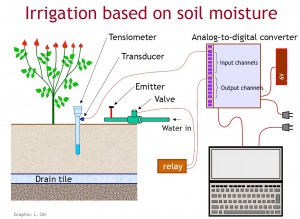 Irrigation water management consists of determining and controlling the rate, amount, and timing of irrigation water in a planned and efficient manner to promote the desired crop response while minimizing soil erosion and offsite movement of pollutants, including movement to groundwater. Irrigation water management consists of determining and controlling the rate, amount, and timing of irrigation water in a planned and efficient manner to promote the desired crop response while minimizing soil erosion and offsite movement of pollutants, including movement to groundwater. |
Furrow Alignm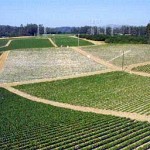 ent: Crop rows are established on planned grades and lengths to slow the rate of runoff from rainfall or irrigation events. This practice reduces erosion in furrow bottoms and the occurrence of furrow blowouts, and optimizes distribution of irrigation water. ent: Crop rows are established on planned grades and lengths to slow the rate of runoff from rainfall or irrigation events. This practice reduces erosion in furrow bottoms and the occurrence of furrow blowouts, and optimizes distribution of irrigation water. |
Vegetated Wate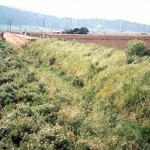 rway: A vegetated waterway is a natural or constructed channel that is shaped and planted with suitable vegetation for the stable transport of runoff. Water quality is improved by capturing sediments or nutrients and preventing waterway erosion. rway: A vegetated waterway is a natural or constructed channel that is shaped and planted with suitable vegetation for the stable transport of runoff. Water quality is improved by capturing sediments or nutrients and preventing waterway erosion. |
Rural Road 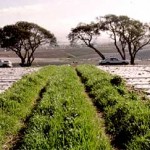 Management: Field access roads that are not frequently used in the winter can be seeded with quick growing winter grasses such as barley or ryegrass. Roads with more frequent use should be graded to minimize the flow of runoff on the road surface or may be surfaced with gravel. Management: Field access roads that are not frequently used in the winter can be seeded with quick growing winter grasses such as barley or ryegrass. Roads with more frequent use should be graded to minimize the flow of runoff on the road surface or may be surfaced with gravel. |
Irrigation Evalu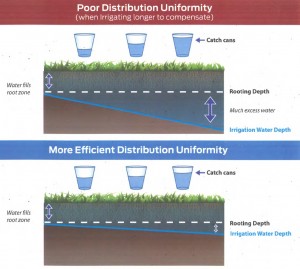 ation: Distribution Uniformity calculates how evenly water is applied to the field during irrigation. Even application across the entire field prevents over or under-watered areas due to differences. DU is the basis of irrigation management practices. ation: Distribution Uniformity calculates how evenly water is applied to the field during irrigation. Even application across the entire field prevents over or under-watered areas due to differences. DU is the basis of irrigation management practices. |
Cover Crops: 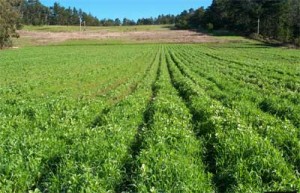 Cover crops are grown in rotation with annual row crops or inter-planted with perennial orchards, vineyards, and cane berries. Cover cropping can control winter soil erosion, add organic matter and nutrients to the soil, and can filter sediment. Cover crops are grown in rotation with annual row crops or inter-planted with perennial orchards, vineyards, and cane berries. Cover cropping can control winter soil erosion, add organic matter and nutrients to the soil, and can filter sediment. |
Integrated P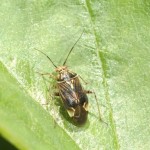 est Management: IPM is not a single pest control method. It involves a series of pest management decisions based on monitoring & identifying pests, setting action thresholds, preventing pests through selecting pest resistant varieties & other practices, and controlling pests through choosing the best method for pest removal (e.g. beneficial insects, targetted spraying, mechanical control). est Management: IPM is not a single pest control method. It involves a series of pest management decisions based on monitoring & identifying pests, setting action thresholds, preventing pests through selecting pest resistant varieties & other practices, and controlling pests through choosing the best method for pest removal (e.g. beneficial insects, targetted spraying, mechanical control). |
Treat, capture or filter water before it leaves the property.
Tail Water Recovery System: 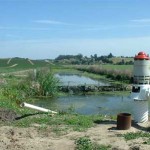 An irrigation tailwater water recovery system captures runoff from irrigation events in a pond for reuse in a farm irrigation distribution system or for dust control on roads. This practice conserves irrigation water supplies and protects surface water quality by collecting and reusing runoff that may contain sediments, nutrients, or pesticides. An irrigation tailwater water recovery system captures runoff from irrigation events in a pond for reuse in a farm irrigation distribution system or for dust control on roads. This practice conserves irrigation water supplies and protects surface water quality by collecting and reusing runoff that may contain sediments, nutrients, or pesticides. |
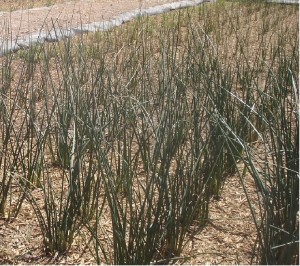 Woodchip Bioreactor: Remove excess nitrate through installing a woodchip bioreactor. |
Sediment Control Basin:  A water and sediment control basin temporarily captures excess rainfall or irrigation runoff and eroded sediment. An outlet pipe is sized to allow the basin to dry down between storm or irrigation events. The purpose is to detain water long enough for most of the sediment to settle and be retained while allowing the cleaner water to flow downstream at a slower rate. A water and sediment control basin temporarily captures excess rainfall or irrigation runoff and eroded sediment. An outlet pipe is sized to allow the basin to dry down between storm or irrigation events. The purpose is to detain water long enough for most of the sediment to settle and be retained while allowing the cleaner water to flow downstream at a slower rate. |
For more detailed information on farm management practices that can protect water quality and why water quality protection matters, check out our Toolkits. Other sites with information include:
For Home Keepers
1. Be aware of materials and products used around the home and landscape that are pollution sources (fertilizer, soaps, pesticides, pathogens, medications, oil, paint). Keep pollutants out of the path of stormwater by storing, handling, using, and disposing of them only as needed and recommended.
2. Keep fertilizer and pesticide granules off paved and other impermeable surfaces. Do not hose or sweep them into the street.
3. Select fertilizers based on soil test results and calibrate spreaders to ensure application of the correct amount. Avoid over applying products, thus increasing the risk of runoff pollution. Consider using low/no phosphorous fertilizer.
4. Use smart pest management practices. Positively identify the cause of plant damage and the best control methods before treating. Apply pesticides at the correct time and recommended rate to control harmful pests. Read and follow all label directions for application, storage, and disposal. Select the least toxic pesticide that will effectively control identified pests. Use adapted, pest-resistant plants.
5. Store household hazardous waste (pesticides, paint thinners, cleaning products, oil, anti-freeze, etc.) according to label direction and dispose of them at a proper hazardous waste disposal site. Do not dump old or excess products into the sink or toilet, street gutter or ditch, storm drain, or onto the ground. Clean up spills immediately.
6. Clean roof gutters and street curbs of tree leaves, grass clippings, sediment, litter, and other debris. Tend to a storm drain in your neighborhood to keep it clear of plant waste and other debris.
7. Pick up litter and clean oil drips and fluid spills from pavement.
8. Scoop pet feces, secure in bag and place in the trash for disposal.
9. Wash cars at a commercial carwash, not in the driveway. Driving cars onto lawns to wash them causes wear and tear on turfgrass and soil compaction that can lead to additional runoff of water.
10. Maintain plant cover on slopes to stabilize soil. Protect bare soil from erosion during construction and when completing landscape renovation projects by using straw bales, compost blankets, or commercial silt fencing.
11. If residing on a lake or stream or have a pond, do not plant turfgrass right up to the water’s edge. Instead, install a vegetated buffer area of native and adapted low-maintenance plants (grasses, forbs, trees) that will intercept and filter pollutant runoff, improve wildlife habitat, and add an aesthetic feature to your property.